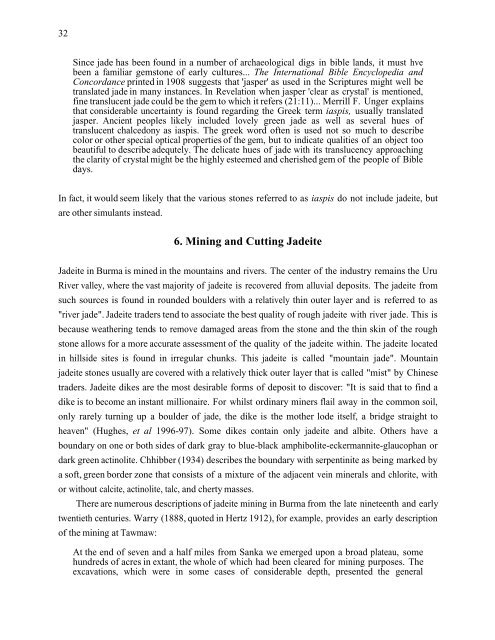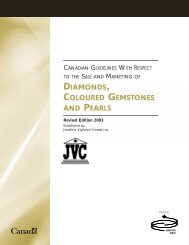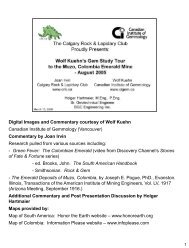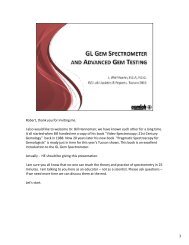JADEITE - Canadian Institute of Gemmology
JADEITE - Canadian Institute of Gemmology
JADEITE - Canadian Institute of Gemmology
You also want an ePaper? Increase the reach of your titles
YUMPU automatically turns print PDFs into web optimized ePapers that Google loves.
32<br />
Since jade has been found in a number <strong>of</strong> archaeological digs in bible lands, it must hve<br />
been a familiar gemstone <strong>of</strong> early cultures... The International Bible Encyclopedia and<br />
Concordance printed in 1908 suggests that 'jasper' as used in the Scriptures might well be<br />
translated jade in many instances. In Revelation when jasper 'clear as crystal' is mentioned,<br />
fine translucent jade could be the gem to which it refers (21:11)... Merrill F. Unger explains<br />
that considerable uncertainty is found regarding the Greek term iaspis, usually translated<br />
jasper. Ancient peoples likely included lovely green jade as well as several hues <strong>of</strong><br />
translucent chalcedony as iaspis. The greek word <strong>of</strong>ten is used not so much to describe<br />
color or other special optical properties <strong>of</strong> the gem, but to indicate qualities <strong>of</strong> an object too<br />
beautiful to describe adequtely. The delicate hues <strong>of</strong> jade with its translucency approaching<br />
the clarity <strong>of</strong> crystal might be the highly esteemed and cherished gem <strong>of</strong> the people <strong>of</strong> Bible<br />
days.<br />
In fact, it would seem likely that the various stones referred to as iaspis do not include jadeite, but<br />
are other simulants instead.<br />
6. Mining and Cutting Jadeite<br />
Jadeite in Burma is mined in the mountains and rivers. The center <strong>of</strong> the industry remains the Uru<br />
River valley, where the vast majority <strong>of</strong> jadeite is recovered from alluvial deposits. The jadeite from<br />
such sources is found in rounded boulders with a relatively thin outer layer and is referred to as<br />
"river jade". Jadeite traders tend to associate the best quality <strong>of</strong> rough jadeite with river jade. This is<br />
because weathering tends to remove damaged areas from the stone and the thin skin <strong>of</strong> the rough<br />
stone allows for a more accurate assessment <strong>of</strong> the quality <strong>of</strong> the jadeite within. The jadeite located<br />
in hillside sites is found in irregular chunks. This jadeite is called "mountain jade". Mountain<br />
jadeite stones usually are covered with a relatively thick outer layer that is called "mist" by Chinese<br />
traders. Jadeite dikes are the most desirable forms <strong>of</strong> deposit to discover: "It is said that to find a<br />
dike is to become an instant millionaire. For whilst ordinary miners flail away in the common soil,<br />
only rarely turning up a boulder <strong>of</strong> jade, the dike is the mother lode itself, a bridge straight to<br />
heaven" (Hughes, et al 1996-97). Some dikes contain only jadeite and albite. Others have a<br />
boundary on one or both sides <strong>of</strong> dark gray to blue-black amphibolite-eckermannite-glaucophan or<br />
dark green actinolite. Chhibber (1934) describes the boundary with serpentinite as being marked by<br />
a s<strong>of</strong>t, green border zone that consists <strong>of</strong> a mixture <strong>of</strong> the adjacent vein minerals and chlorite, with<br />
or without calcite, actinolite, talc, and cherty masses.<br />
There are numerous descriptions <strong>of</strong> jadeite mining in Burma from the late nineteenth and early<br />
twentieth centuries. Warry (1888, quoted in Hertz 1912), for example, provides an early description<br />
<strong>of</strong> the mining at Tawmaw:<br />
At the end <strong>of</strong> seven and a half miles from Sanka we emerged upon a broad plateau, some<br />
hundreds <strong>of</strong> acres in extant, the whole <strong>of</strong> which had been cleared for mining purposes. The<br />
excavations, which were in some cases <strong>of</strong> considerable depth, presented the general









